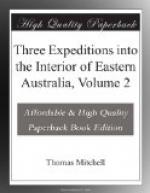That some affinity exists between such accumulations and the salt water in the lakes is the more probable from the present state of those of Cockajemmy, which occur in the bed of a former current, and between the rocky sides of a kind of ravine. Even in such a situation a mound of very firm ground has been formed on the eastern bank of each, and was found very convenient for the passage of the ravine by the carts of the party. (See above.)
In those hills beside salt lakes on the plains a tendency to regular curvature was the chief feature: the relative situation with respect to the water and the wind was always the same; while in some cases, where grassy flats had once been lakes, crescent-shaped green mounds were still apparent on the north-eastern sides of each. If these remains of salt water are of less volume than they have been formerly, as may be presumed from these circumstances; and if the waters according to Professor Faraday’s analysis “are solutions of common salt and, except in strength, very much resemble those of the ocean,"* we cannot have much difficulty in believing that the sea deposited the water in these situations at no very remote period.
As a dark-coloured soil is also found in the ridges about some of these lakes we must look deeper for the original cause of such depressions in those extensive plains; and may attribute them either to cavities or protuberances in the lower rocks, which may not have been sufficiently filled or covered by the superincumbent deposits: or they may be due to partial subsidences in a thin stratum of limestone.
CHANGES ON THE SEACOAST. PROOFS THAT THE COAST WAS ONCE HIGHER ABOVE THE SEA THAN IT IS AT PRESENT. PROOFS THAT IT WAS ONCE LOWER. AND OF VIOLENT ACTION OF THE SEA.
The sea, probably when higher relatively to the land than it is at present, appears to have acted with some violence in isolating various points along the eastern coast; most of which we now find curiously analogous, in their situation on the southern sides of inlets, and in being now united to the mainland by mounds of sand.
AT WOLLONGONG.
The point of Wollongong was formerly an island and is now only connected by drifted sandhills with the site of the township.
CAPE SOLANDER.
Cape Solander, the south head of Botany Bay, on which Captain Cook first landed, was evidently once an island though at present connected with the mainland by the neck of sand which separates Botany Bay from Port Hacking.
PORT JACKSON.
The south head of Port Jackson has also been isolated but is again connected with the shore of Bellevue between Bondi Bay and Rose Bay, by drifted hills of sand. The north head appears to have been likewise isolated.
BROKEN BAY.
Barrenjoey, the south head of Broken Bay, is connected only by a low beach of sand.
NEWCASTLE.
The Beacon head of Newcastle was once an island; and the drifted sand forming the hills on which the town is built has since been thrown up by the sea.




